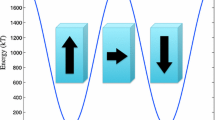Abstract
This paper proposes a full-transistor multilevel delay element (DE) implemented by 65 nm/1.8 V CMOS technology. 10 mV/LSB and 50 mV/LSB control voltages are employed to realize the fine-grain and coarse tuning for multilevel delay adjustment while maintain the duty cycle of input pulse. In physical design, a novel transistor array with a compact regularity layout is adopted to mitigate process variation. According to the post-layout simulation analysis, compared with two traditional delay elements, the proposed DE has particular advantages in terms of the layout area as well as achieves the acceptable merely 2× power consumption and 22.9% delay quantization error in linearity accuracy. The effective 2 MHz bandwidth and nano-second delay range is applicable to a low/medium frequency clock compensation system.






Similar content being viewed by others
References
Zhang, G. L., Li, B., Shi, Y., Hu, J., & Schlichtmann, U. (2018). EffiTest2: Efficient delay test and prediction for post-silicon clock skew configuration under process variations. IEEE Transactions on Computer-Aided Design of Integrated Circuits and Systems,38(4), 705–718.
Singhvi, A., Moreira, M. T., Tadros, R. N., Calazans, N. L. V., & Beerel, P. A. (2016). A fine-grain, uniform, energy-efficient delay element for 2-phase bundled-data circuits. ACM Journal on Emerging Technologies in Computing Systems,13(2), 1–23.
Yang, J., Chao, C., & Lin, S. (2006). Tunable delay element for low power VLSI circuit design. In TENCON—IEEE region 10 conference 2006. https://doi.org/10.1109/TENCON.2006.344092.
Moon, B. M., Park, Y. J., & Jeong, D. K. (2008). Monotonic wide-range digitally controlled oscillator compensated for supply voltage variation. IEEE Transactions on Circuits and Systems II: Express Briefs,55(10), 1036–1040.
Heck, G., Heck, L. S., Singhvi, A., Moreira, M. T., Beerel, P. A., Calazans, N. L. V., et al. (2015). Analysis and optimization of programmable delay elements for 2-phase bundled-data circuits. In 2015 28th international conference on VLSI design. https://doi.org/10.1109/VLSID.2015.60.
Ryu, K., Jung, D., & Jung, S. (2013). All-digital process-variation-calibrated timing generator for ATE with 1.95-ps resolution and a maximum 1.2-GHz test rate. In 2013 proceedings of the ESSCIRC (ESSCIRC). https://doi.org/10.1109/esscirc.2013.6649067.
Dogsa, T., Solar, M., & Jarc, B. (2014). Precision delay circuit for analog quadrature signals in sin/cos encoders. IEEE Transactions on Instrumentation and Measurement,63(12), 2795–2803.
Dwivedi A. K., Guduri M., Mehra R., & Islam A. (2016). A monotonic digitally controlled delay element-based programmable trigger pulse generator. In S. Satapathy, K. Raju, J. Mandal, V. Bhateja (Eds.), Proceedings of the 2nd international conference on computer and communication technologies.Advances in intelligent systems and computing (Vol. 379, pp. 365–374). New Delhi, India: Springer. https://doi.org/10.1007/978-81-322-2517-1_36.
Murooka, D., Zhang, Y., Dong, Q., & Nakatake, S. (2015). Low-power and low-variability programmable delay element and its application to post-silicon skew tuning. In IEEE computer society annual symposium on VLSI. https://doi.org/10.1109/ISVLSI.2015.91.
Zhang, R., & Kaneko, M. (2015). Robust and low-power digitally programmable delay element designs employing neuron-MOS mechanism. ACM Transactions on Design Automation of Electronic Systems,20(4), 1–19.
Wang, W., Zhou, H., Ye, F., & Ren, J. (2015). An 8-bit 4 fs-step digitally controlled delay element with two cascaded delay units. In IEEE 11th international conference on ASIC. https://doi.org/10.1109/ASICON.2015.7517034.
Angeli, N., & Hofmann, K. (2018). A low-power and area-efficient digitally controlled shunt-capacitor delay element for high-resolution delay lines. In 25th IEEE international conference on electronics circuits and systems. https://doi.org/10.1109/ICECS.2018.8617948.
Gauci, J. L., Gatt, E., Casha, O., De Cataldo, G., Grech, I., & Micallef, J. (2018). Design of a quasi-linear rail-to-rail delay element with an extended programmable range. In 25th IEEE international conference on electronics circuits and systems. https://doi.org/10.1109/ICECS.2018.8617855.
Imai, M., Akasaka, S., & Yoneda, T. (2018). Novel delay elements for bundled-data transfer circuits based on two-phase handshaking protocols. In 24th IEEE international symposium on asynchronous circuits and systems. https://doi.org/10.1109/ASYNC.2018.00012.
Ghazizadeh, M. H., & Medi, A. (2019). A 125-ps 8-18-GHz CMOS integrated delay circuit. IEEE Transactions on Microwave Theory and Techniques,67(1), 162–173.
Dwivedi, A. K., Mal, A., & Islam, A. (2017). Analysis of various delay elements @ 16-nm technology node. In International conference on intelligent computing and control. https://doi.org/10.1109/I2C2.2017.8321786.
Yang, B., Dong, Q., Li, J., & Nakatake, S. (2010). Structured analog circuit design and MOS transistor decomposition for high accuracy applications. In IEEE/ACM international conference on computer-aided design. https://doi.org/10.1109/ICCAD.2010.5654264.
Liu, B., Chen, G., Yang, B., & Nakatake, S. (2018). Routable and matched layout styles for analog module generation. ACM Transactions on Design Automation of Electronic Systems,23(4), 1–17.
Chen, G., Fujimura, T., Dong, Q., Nakatake, S., & Yang, B. (2016). DC characteristics and variability on 90 nm CMOS transistor array-style analog layout. ACM Transactions on Design Automation of Electronic Systems,21(3), 1–21.
Geng, C., Liu, B., & Nakatake, S. (2017). Explicit layout pattern density controlling based on transistor-array-style. In IEEE 60th international midwest symposium on circuits and systems. https://doi.org/10.1109/mwscas.2017.8053233.
Acknowledgements
This work was partially supported by the National Natural Science Foundation of China (NSFC, Grant Nos. 61704049, 61804046), the Key Scientific Research Projects of Higher Education Institutions in Henan Province (Grant No. 19A510012), the Foundation of Department of Science and Technology of Henan Province (Grant Nos. 182102210295, 192102210087, 202102210322).
Author information
Authors and Affiliations
Corresponding authors
Additional information
Publisher's Note
Springer Nature remains neutral with regard to jurisdictional claims in published maps and institutional affiliations.
Rights and permissions
About this article
Cite this article
Liu, B., Huang, Zh., Zhang, Jc. et al. A full-transistor fine-grain multilevel delay element with compact regularity layout. Analog Integr Circ Sig Process 103, 163–172 (2020). https://doi.org/10.1007/s10470-020-01588-y
Received:
Revised:
Accepted:
Published:
Issue Date:
DOI: https://doi.org/10.1007/s10470-020-01588-y




